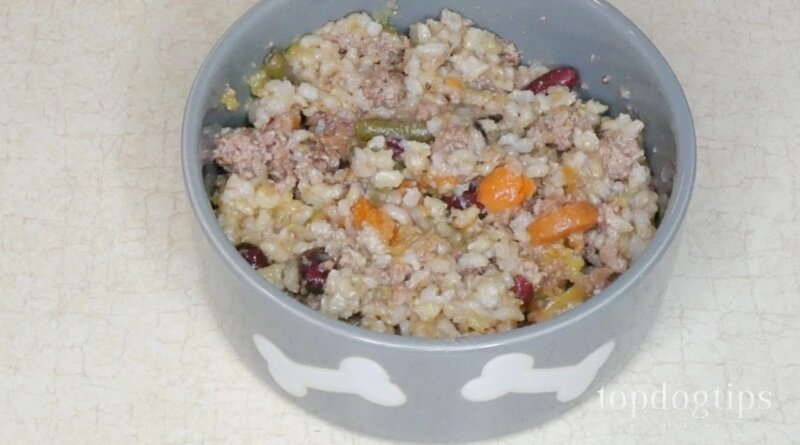Slow Cooker Beef Stew Food for Dogs with Digestive Problems – Top Dog Tips
Digestive problems in dogs can range from mild, short lived issues to severe, long-term diseases. It may be as simple as your dog having eaten something that he shouldn’t have or it could be a parasite, bacteria or virus that is causing the problem. Before switching your pup to food for dogs with digestive problems, it’s best to seek help from your veterinarian to find the root cause of the issues.
Dogs are well-known for eating just about anything. From getting into the garbage to eating things they’ve found in the woods, canines will eat some pretty gross stuff! Unfortunately, eating these things is what usually leads to digestive upset.
Signs of digestive problems in dogs include:
- abdominal pain
- excessive drooling
- constipation and/or diarrhea
- vomiting
- loss of appetite
As I mentioned, if you are concerned that your dog may be having digestive troubles, seek veterinary help immediately. While the problem may pass on its own, digestive disorders could lead to serious and irreversible health problems if left untreated. While it may just be that he ate something yucky, it could also be a blockage or serious virus that requires medical attention.
Do not switch your pet to this food for dogs with digestive problems without consulting your veterinarian first. They can guide you on the proper treatment depending on the cause of your dog’s stomach troubles. They can also help you to determine if this recipe will provide your dog with balanced nutrition.
Slow Cooker Beef Stew Food for Dogs with Digestive Problems

Recipe: Slow Cooker Beef Stew Food for Dogs with Digestive Problems
Before switching your pet to homemade dog food for digestive health, it’s best to ask your veterinarian for advice. They will evaluate your dog to decide if this recipe will provide the balanced nutrition that he needs. They may recommend a slight change in ingredients or the addition of supplements.
- Prep Time: 15 minutes
- Cook Time: 4 hours
- Total Time: 4 hours 15 minutes
- Yield: about 16 cups of food 1x
- Category: Cooked Food
- Method: Slow Cooker
- Cuisine: Dog Food
- 2 ½ lb. lean ground beef
- 15 oz. can dark red kidney beans, drained and rinsed
- 1 ½ cups quinoa
- 1 ½ cups diced carrots
- 1 ½ cups diced sweet potato
- ½ cup garden peas
- 4 cups water
Many owners don’t have the extra time to prepare homemade dog food for their canine companions. Of course there is still a bit of prep work, but using a crock pot makes it possible for even the busiest dog owner to feed their dog a homemade diet.
As with most slow cooker recipes, this one is very simple to make. It takes me about 15 minutes to cut up all of the vegetables for this recipe, and that’s all the work you need to do.
Just add all the ingredients to your slow cooker and stir the dog food occasionally as it cooks. You can cook this recipe for 4 hours on the ‘high’ setting or 7 hours on the ‘low’ setting.
Once the food has cooled completely, stir until all of the ingredients are equally combined and serve it to your pup.
Nutrition
- Serving Size: 1/2 cup
- Calories: 117
- Sugar: 1 g
- Sodium: 47 mg
- Fat: 2.8 g
- Carbohydrates: 9.6 g
- Fiber: 1.6 g
- Protein: 12.9 g
- Cholesterol: 32 mg
Serving Size Recommendation: You can serve this food to your dog as soon as it has cooled. I recommend feeding about 1/2 cup of food for every 20-25 pounds of body weight. This recommendation is for 2 servings per day. So, a 25-pound dog would eat about 1/2 cup in the morning and 1/2 cup in the evening.
This is just a guideline. Some dogs, like working dogs and very active breeds, will need more calories than this. Lazier pets and senior dogs may not need as many.
It’s best to consult your veterinarian about the appropriate serving size for you dog. They will also help you evaluate meal to make sure it will meet your pet’s unique nutritional needs. If necessary, they will assist you in choosing the best supplements and/or multivitamins to add.
How to store: You can store the leftover dog food for dogs with digestive problems in an airtight container in the refrigerator for 3-5 days or freeze them, and they’ll keep for up to 3 months. Keep in mind that this recipe includes no preservatives, so that it won’t last nearly as long as commercial dog food.
Related





